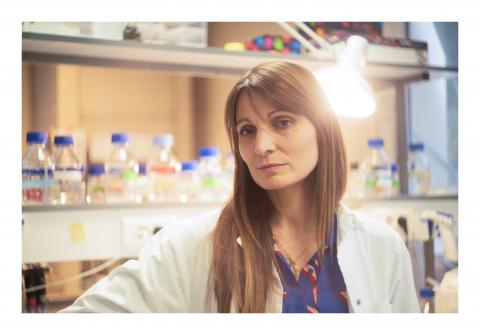
Aurélie Albertini: Defying and diverting viruses
Aurélie Albertini is a researcher at the Department of Virology of the Institut de biologie intégrative de la cellule (I2BC - UMR Université Paris-Saclay, CEA, CNRS). She studies Rhabdoviruses, as part of the "Rhabdoviridae" team led by Yves Gaudin. This fundamental research resonates with current affairs and offers up possible applications in the area of oncology and gene therapy.
The vesicular stomatitis virus (VSV) belongs to the family of Rhabdoviruses, which include pathogens that are dangerous for humans, such as the rabies virus. The laboratory where Aurélie Albertini works is used as a model to study the fundamental processes of virology “as it is a Class 2 pathogen, which has a low risk to humans and which can be produced in large quantities with different cell types”.
Finding the key
Aurélie Albertini studies the moment when the virus enters the cell. “I observe how viral fusion glycoproteins work; these are found on the surface of the virus and enable membranes to fuse. There are two compartments separated by a membrane: one surrounding the virus and another surrounding the cell being infected. It is necessary for these two compartments to merge and join their membranes for the virus to infect the cell”, Albertini explains. Glycoprotein acts as a “key” when coming into contact with a receiver (the “lock”) located at the cell’s surface. This contact causes the viral particle to be internalised into the cell. Next, when the virus is in an initial “compartment” called the endosome, the pH of the medium decreases, the protein changes its conformation and the two membranes fuse.
Implications for oncology
While VSV research is a fundamental and “inexhaustible” area, it can also give rise to health applications. As of 2013, Aurélie Albertini has managed to identify key residues on the VSV glycoprotein, which interact with its cell receptor. This virus, which especially likes to multiply in cancer cells is a promising tool for cancer therapy. “The problem is that VSV also infects healthy cells”, she notes. So thanks to the identification of these residues, Albertini and her team hope to “make viruses that no longer penetrate healthy cells, but only those to be eliminated”. She has just patented this technology and has obtained funding to take her research even further, which may have a significant impact on oncology. “We are currently at the stage of proving a concept to develop VSV glycoproteins that would specifically target breast cancer cells, for example”, says Aurélie Albertini, whose project is currently funded by the ARC Foundation for cancer research and has been integrated into CNRS’ pre-maturation programme.
“Our research covers a wide scope ranging from the cellular to the molecular – virology, cell and structural biology – and is based on high-level technology, explains Albertini. We know how to make viruses and isolated proteins. We perform functional studies and structural analysis using electron microscopy as well as X-ray crystallography. On these aspects, we also work regularly with the synchrotron”. Together with her team, she has just published an article in the PLoS Pathogens journal on the glycoprotein of Mokola virus, a similar pathogen to rabies.
The virus of viruses
Aurélie has been geared towards virology since undertaking her Master 2 internship with Rob Ruigrok, who became her thesis supervisor. She defended her thesis in 2006 at Université Joseph Fourier in Grenoble. Albertini studied the replication and transcription of negative-strand RNA viruses (such as the rabies virus, VSV, Nipah virus and measles). Her articles published during her thesis gained attention and paved the way for her to join the I2BC, first as a post-doctoral fellow under Yves Gaudin’s team, and then as a researcher once recruited by CNRS in 2013.
Aurélie Albertini has just received CNRS’ 2020 Bronze Medal. An honour as much for herself, as for her team and family.
